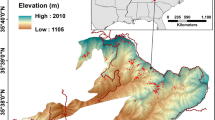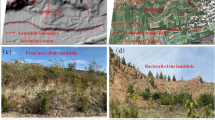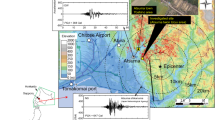Abstract
For massive engineering projects in high and steep mountain areas, toppling deformation, which is an important geological engineering problem in construction, has been observed. Three key issues in the early warning of toppling slopes are the boundary conditions, the evolution mechanism, and deformation stability analysis. This paper investigates an evolution mechanism for the timely prediction of block toppling-induced slope failure in rock masses and examines the relationship between boundary formation and the progressive development of toppling fracture planes. By describing an instantaneous toppling velocity field and identifying two possible fracture plane geometries (linear and parabolic), the optimal path of the toppling fracture plane is searched based on calculations of the critical toppling height (i.e., minimum load) and the upper bound theory of limit analysis. Regardless of the slope structures and mechanical parameters, the optimal path of the toppling fracture plane is straight and most likely oriented perpendicular to the bedding planes. Therefore, considering that structural damage will enable progressive toppling deformation instead of systemic failure, the evolution of block toppling deformation likely replaces the loop following the formation of the first fracture plane because the slope critical height is exceeded. In the loop, the deformation and inclination of columns is updated due to the formation and inclination of fracture planes, which may be perpendicular to the columns. This progressive formation of more inclined fracture planes leads to sliding collapse. The block toppling evolution is divided into 5 stages, and the instability criterion for the transformation of toppling deformation into sliding collapse is defined as the inclination of the fracture plane being equal to its friction angle. In addition, a PFC2D simulation of the entire slope toppling process is performed to verify this speculative evolution mechanism, and a satisfactory result is acquired. Finally, a deformation calculation model of slope block toppling is proposed for stability analysis in accordance with the instability criterion, which is further applied in a typical toppling case. The findings of this study provide a foundation for the deformation, stability and early-warning analysis of block toppling slopes.















Similar content being viewed by others
References
Adhikary DP, Dyskin AV (2007) Modelling of progressive and instantaneous failures of foliated rock slopes. Rock Mech Rock Eng 40(4):349–362
Adhikary D, Dyskin AV, Jewell RJ (1996) Numerical modelling of the flexural deformation of foliated rock slopes. Int J Rock Mech Mining Sci Geomech Abstracts 33(6):595–606
Adhikary D, Dyskin AV, Jewell RJ et al (1997) A study of the mechanism of flexural toppling failure of rock slopes. Rock Mech Rock Eng 30(2):75–93
Amini M, Majdi A, Veshadi MA (2012) Stability analysis of rock slopes against block-flexure toppling failure. Rock Mech Rock Eng 45(4):519–532
Aydan O, Kawamoto T (1992) The stability of slopes and underground openings against flexural toppling and their stabilization. Rock Mech Rock Eng 25(3):143–165
Berkovitz LD (1974) Optimal control theory. Springer-Verlag
Bovis MJ, Stewart TW (1998) Long-term deformation of a glacially undercut rock slope, Southwest British Columbia. In: Hungr O, Moore DP (eds) 8th international IAEG congress. Vancouver, British Columbia, pp 1267–1275.
Chen WF (1975) Limit analysis and soil plasticity. Elsevier Scientific Publishing Company, New York
Chen CX, Zheng Y, Sun CY (2016) An analytical approach on flexural toppling failure of counter-tilt slopes of layered rock. Chin J Rock Mech Eng 35(11):2174–2187 (in Chinese)
Feng ZY, Lo CM, Lin QF (2016) The characteristics of the seismic signals induced by landslides using a coupling of discrete element and finite difference methods. Landslides 14(2):1–14
González E, Herreros MI, Pastor M, Quecedo M, Fernández Merodo JA (2002) Discrete and continuum approaches for fast landslide modeling. In: Numerical modeling in micromechanics via particle methods. In: Proceedings of the 1st International PFC Symposium, Gelsenkirchen, Germany, pp 307–313.
Goodman RE, Bray JW (1976) Toppling of rock slopes. Proceedings, specialty conference on rock engineering for foundations and slopes, vol 2. American Society of Civil Engineering, Boulder, CO, pp 201–234
Goricki A, Goodman RE (2003) Failure modes of rock slopes demonstrated with base friction and simple numerical models. Felsbau 21(2):25–30
Hoek E, Bray JW (1981) Rock slope engineering. Institute of Mining and Metallurgy, London, UK.
Hoek E, Bray EJ (1977) Rock slope engineering (Revised, 2nd edn. Institution of Mining and Metallurgy, London
Hoek E, Carter TG, Diederichs MS (2013) Quantification of the Geological Strength Index Chart. In proceedings of the 47th US Rock Mechanics Symposium. American Rock Mechanics Association, San Francisco, Calif.
Huang RQ (2008) Geodynamical process and stability control of high rock slope development. Chin J Rock Mech Eng 27(8):1525–1544 (in Chinese)
Huang RQ, Li YS, Yan M (2017) The implication and evaluation of toppling failure in engineering geology practice. Chinese J Eng Geol 25(5):1165–1181 ((in Chinese))
Itasca Consulting Group, Inc (2017) PFC2D-particle flow code in 2-dimensions. Itasca Consulting Group, Inc., Minneapolis, MN
Wolfram Research, Inc (2014) Mathematica, Version 10.0, Wolfram Research, Inc., Champaign, IL.
Ishida T, Chigira M, Hibino S (1987) Application of the distinct element method for analysis of toppling observed on a fissured rock slope. Rock Mech Rock Eng 20(4):277–283
Liu CH, Jaksa MB, Meyers AG (2009) A transfer coefficient method for rock slope toppling. Can Geotech J 46(1):1–9
Liu M, Liu FZ, Huang RQ (2016) Deep-seated large-scale toppling failure in metamorphic rocks: a case study of the Erguxi slope in southwest China. J Mt Sci 13(12):2094–2110
Nichol SL, Hungr O, Evans SG (2002) Large-scale brittle and ductile toppling of rock slopes. Can Geotech J 39(4):773–788
Ning Y, Tang H, Zhang G, Smith JV, Zhang B, Shen P, Chen H (2021) A complex rockslide developed from a deep-seated toppling failure in the upper Lancang River, Southwest China. Eng Geol, 106329.
Popov EP (1976) Mechanics of materials, 2nd edn. Prentice-Hall Inc, Englewood Cliffs
Pritchard MA, Savigny KW (1990) Numerical modelling of toppling. Can Geotech J 27(6):823–834
Sarfaraz H (2020) Stability analysis of flexural toppling failure using the Sarma’s method. Geotech Geol Eng 38(4):3667–3682
Sarfaraz H (2021) An analytical solution for analysis of block toppling failure using approach of fictitious horizontal acceleration. J Min Sci 57(2):202–209
Stacey TR (2006) Considerations of failure mechanisms associated with rock slope instability and consequences for stability analysis. J South African Inst Mining Metallurgy 106(7):485–493
Tosney JR, Milne D, Chance AV et al (2004) Verification of a large scale slope instability mechanism at Highland Valley Copper. Int J Surf Min Reclam Environ 18(4):273–288
Tu G, Deng H (2020) Characteristics of a deep-seated flexural toppling fracture and its relations with downcutting by the Lancang River: A case study on a steeply dipping layered rock slope. Southwest China Eng Geol 275:105754
Tu G, Deng H, Shang Q, Zhang Y, Luo X (2021) Effect of unloading in two directions on the formation of a deep-seated flexural toppling failure. Int J Rock Mech Min Sci 142:104790
Wang SJ (1981) On the mechanism and process of slope deformation in an open pit mine. Rock Mech 13(3):145–156
Wei J, Zhao Z, Xu C, Wen Q (2019) Numerical investigation of landslide kinetics for the recent mabian landslide (sichuan, china). Landslides, 16(4).
Yeung MR, Wong KL (2007) Three-dimensional kinematic conditions for toppling. In book: Rock Mechanics: Meeting Society's Challenges and Demands: 335–339.
Zhang JH, Chen ZY, Wang XG (2007) Centrifuge modeling of rock slopes susceptible to block toppling. Rock Mechanism Rock Eng 40(4):363–382
Zhang ZL, Liu G, Wu SR (2014) Rock slope deformation mechanism in Chihaxia Hydropower Station, Northwest China. Bull Eng Geol Env 74(3):943–958
Zhang SS, Pei XJ, Mu JQ (2015) Evolution mechanisms analysis of Xingguangsanzu toppling deformation bodies under condition of impound water of Xiluodu hydropower station. Chin J Rock Mech Eng 34(S2):4091–4098 (in Chinese)
Zhang G, Wang F, Zhang H, Tang H, Li X, Zhong Y (2018) New stability calculation method for rock slopes subject to flexural toppling failure. Int J Rock Mech Min Sci 106:319–328
Zheng Y, Chen CX, Liu TT et al (2018) Study on the mechanisms of flexural toppling failure in anti-inclined rock slopes using numerical and limit equilibrium models. Eng Geol 237:116–128
Zheng Y, Chen C, Liu T, Zhang H, Sun C (2019) Theoretical and numerical study on the block-flexure toppling failure of rock slopes. Eng Geol 263:105309
Acknowledgements
This study was financially sponsored by the National Natural Science Foundation of China (Grant No. 41907238 and Grant No. 41931296), State Key Laboratory of Geohazard Prevention and Geoenvironment Protection Independent Research Project (SKLGP2021Z008).
Funding
Funding was provided by the National Natural Science Foundation of China (Grant No. 41907238 and Grant No. 41931296), State Key Laboratory of Geohazard Prevention and Geoenvironment Protection Independent Research Project (SKLGP2021Z008).
Author information
Authors and Affiliations
Corresponding author
Ethics declarations
Conflict of interest
The authors declared that they have no conflicts of interest in this work. We declare that we do not have any commercial or associative interests that represents a conflict of interest in connection with the work submitted.
Additional information
Publisher's Note
Springer Nature remains neutral with regard to jurisdictional claims in published maps and institutional affiliations.
Rights and permissions
About this article
Cite this article
Mu, Jq., Li, Tt., Pei, Xj. et al. Evolution mechanism and deformation stability analysis of rock slope block toppling for early warnings. Nat Hazards 114, 1171–1195 (2022). https://doi.org/10.1007/s11069-022-05422-8
Received:
Accepted:
Published:
Issue Date:
DOI: https://doi.org/10.1007/s11069-022-05422-8




